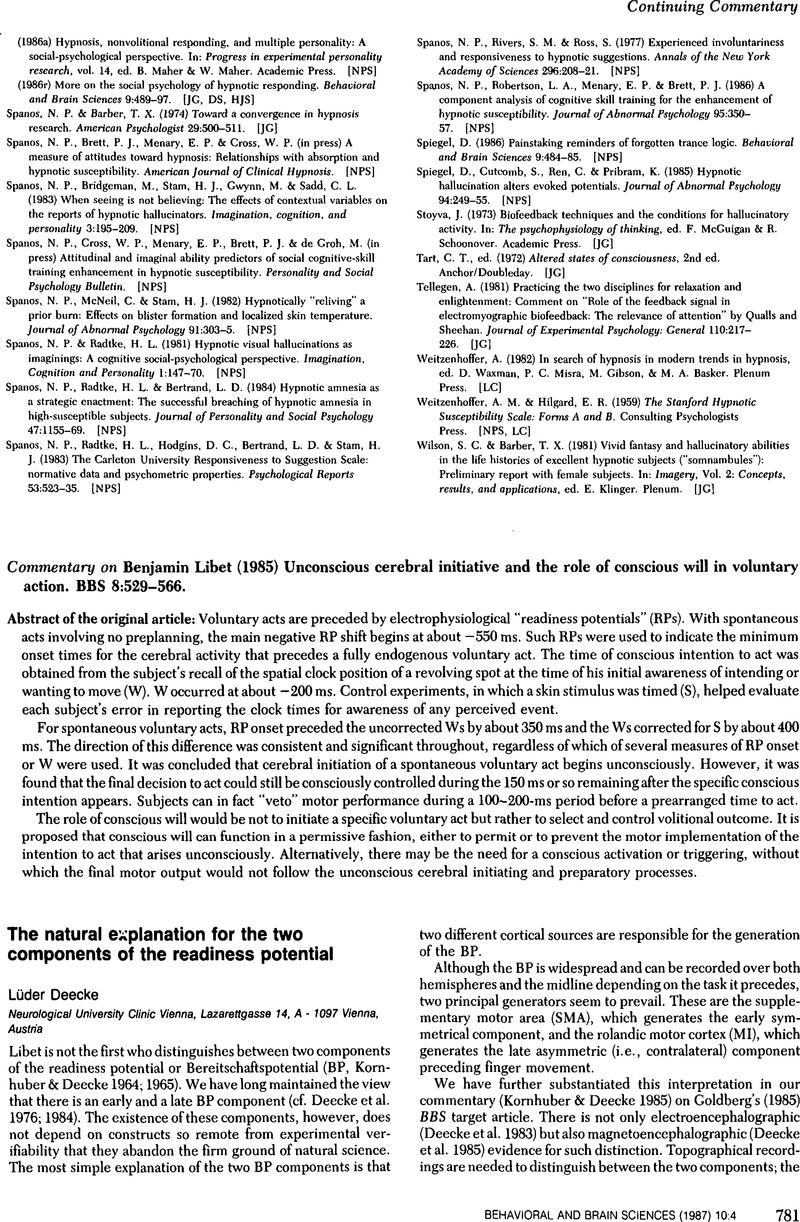No CrossRef data available.
Article contents
The natural explanation for the two components of the readiness potential
Review products
Commentary onLibetBenjamin (1985) Unconscious cerebral initiative and the role of conscious will in voluntary action. BBS 8:529–566.
Published online by Cambridge University Press: 04 February 2010
Abstract
An abstract is not available for this content so a preview has been provided. Please use the Get access link above for information on how to access this content.

Information
- Type
- Continuing Commentary
- Information
- Copyright
- Copyright © Cambridge University Press 1987
References
Bliss, J. (1980) Sensory experiences of Gilles de la Tourette syndrome. Archives of General Psychiatry 37: 1343–47. [REH, BL]CrossRefGoogle ScholarPubMed
Boschert, J., Hink, R. F. & Deecke, L. (1983) Finger movement versus toe movement-related potentials: Further evidence for supplementary motor area (SMA) participation prior to voluntary action. Experimental Brain Research 55: 73–80. [LD]Google Scholar
Breitmeyer, B. G. (1985) Problems with the psychophysics of intention. Behavioral and Brain Sciences 8: 539–40. [REH, BL]CrossRefGoogle Scholar
Cohen, D. J., Riddle, M. A., Leckman, J. F., Ort, S. & Shaywitz, B. A. (1984) Tourette's syndrome. In: Neuropsychiatric movement disorders, ed. Jeste, D. V. & Wyatt, R. J.. American Psychiatric Press. [REH, BL]Google Scholar
Deecke, L., Bashore, T., Brunia, C, Grünewald-Zuberbier, E., Grunewald, G. & Kristeva, R. (1984) Movement associated potentials and motor control. In: Brain and information: Event-related potentials, ed. Karrer, R., Cohen, J. & Tueting, P.. Annals of the New York Academy of Sciences 425: 398–428. [LD]CrossRefGoogle Scholar
Deecke, L., Boschert, J., Brickett, P. & Weinberg, H. (1985) Magnetoencephalographic evidence for possible supplementary motor area participation in human voluntary movement. In: Biomagnetism: Applications and theory, ed. Weinberg, H., Stroink, G. & Katila, T.. Pergamon. [LD]Google Scholar
Deecke, L., Grozinger, B. & Kornhuber, H. H. (1976) Voluntary finger movement in man: Cerebral potentials and theory. Biological Cybernetics 23: 99–119. [LD, BL]CrossRefGoogle ScholarPubMed
Finke, R. (1979) The functional equivalence of mental images and errors in movement. Cognitive Psychology 11: 235–64. [REH, BL]CrossRefGoogle Scholar
Goldberg, G., Kwan, H. C, Borrett, D. & Murphy, J. T. (1984) Differential topography of the movement-associated scalp potential with internal vs. external dependence of movement timing. Archives of Physical Medicine and Rehabilitation 65: 630. [LD, BL]Google Scholar
Gordon, R. M. (1986) The passivity of emotions. Philosophical Review 95: 371–92. [REH]CrossRefGoogle Scholar
Greenwald, A. (1970a) A double stimulation test of ideomotor theory with implications for selective attention. Journal of Experimental Psychology 84: 392–98. [REH]CrossRefGoogle Scholar
Greenwald, A. (1970b) A choice reaction time test of ideomotor theory. Journal of Experimental Psychology 86: 20–25. [REH]CrossRefGoogle ScholarPubMed
Harnad, S. (1982) Consciousness: An afterthought. Cognition and Brain Theory 5: 29–47. [REH, BL]Google Scholar
Hoffman, R. E. (1986) Verbal hallucinations and language production processes in schizophrenia. Behavioral and Brain Sciences 9: 503–48. [REH]CrossRefGoogle Scholar
Jung, R. (1985) Voluntary intention and conscious selection in complex learned action. Behavioral and Brain Sciences 8: 544–45. [BL]CrossRefGoogle Scholar
Kelso, J. A. (1982) Concepts and issues in human motor behavior: Coming to grips with the jargon. In: Human motor behavior, ed. Kelso, J. A.. Erlbaum. [REH, BL]Google Scholar
Kornhuber, H. H. & Deecke, L.: (1964) Hirnpotentiälanderungen beim Menschen vor und nach Willkürbewegungen, dargestellt mit Magnetbandspeicherung und Rückwärtsanalyse. Pfügers Arch. 281: 52. [LD, BL]Google Scholar
Kornhuber, H. H. & Deecke, L. (1965) Hirnpotentialanderungen bei Willkurbewegungen und passiven Bewegungen des Menschen: Bereitschaftspotential und reafferente Potentiale. Pflügers Archiv für Cesamte Physiologie 284: 1–17. [LD, BL]CrossRefGoogle Scholar
Libet, B. (1985) Unconscious cerebral intiative and the role of conscious will in voluntary action. Behavioral and Brain Sciences 8: 529–39, 529–66.CrossRefGoogle Scholar
Libet, B. (1985r) Theory and evidence relating cerebral processes to conscious will. Behavioral and Brain Sciences 8: 558–66. [REH, BL]CrossRefGoogle Scholar
Libet, B., Gleason, C. A., Wright, E. W. & Pearl, D. K. (1983) Time of conscious intention to act in relation to onset of cerebral activities (readiness-potential); the unconscious initiation of a freely voluntary act. Brain 106: 623–42. [BL]CrossRefGoogle ScholarPubMed
Libet, B., Wright, E. W. Jr & Gleason, C. A. (1982) Readiness-potentials preceding unrestricted “spontaneous” vs. preplanned voluntary acts. Electroencephalography and Clinical Neurophysiology 54: 322–35. [BL]CrossRefGoogle ScholarPubMed
MacKay, D. M. (1985) Do we “control” our brains? Behavioral and Brain Sciences 8: 546. [BL]CrossRefGoogle Scholar
Obeso, J. A., Rothwell, J. C. & Marsden, C. D. (1981) Simple tics in Gilles de la Tourette's syndrome are not prefaced by a normal premovement EEG potential. Journal of Neurology, Neurosurgery, and Psychiatry 44: 735–38. [REH, BL]CrossRefGoogle Scholar
Scheerer, E. (1985) Conscious intention is a mental fiat. Behavioral and Brain Sciences 8: 552–53. [REH, BL]CrossRefGoogle Scholar
Shibasaki, H., Barrett, G., Halliday, E. & Halliday, A.M. (1980) Components of the movement-related cortical potential and their scalp topography. Electroencephalography and Clinical Neurophysiology 49: 213–26. [BL]CrossRefGoogle ScholarPubMed
Sperry, R. W. (1976) Changing concepts of consciousness and free will. Perspectives in Biology and Medicine 20: 9–19. [BL]CrossRefGoogle ScholarPubMed
Sperry, R. W. (1980) Mind-brain interaction: Mentalism, yes; dualism, no. Neuroscience 5: 195–206. [BL]CrossRefGoogle Scholar
Wittgenstein, L. (1980) Remarks on the philosophy of psychology, ed. Wright, G. H. von & Nyman, H.. University of Chicago Press. [REH]Google Scholar
Wood, C. C. (1985) Pardon, your dualism is showing. Behavioral and Brain Sciences 8: 557–58. [REH]CrossRefGoogle Scholar
Zivin, G. (1986) Image or neural coding of inner speech and agency? Behavioral and Brain Sciences 9: 534–35. [REH]CrossRefGoogle Scholar

